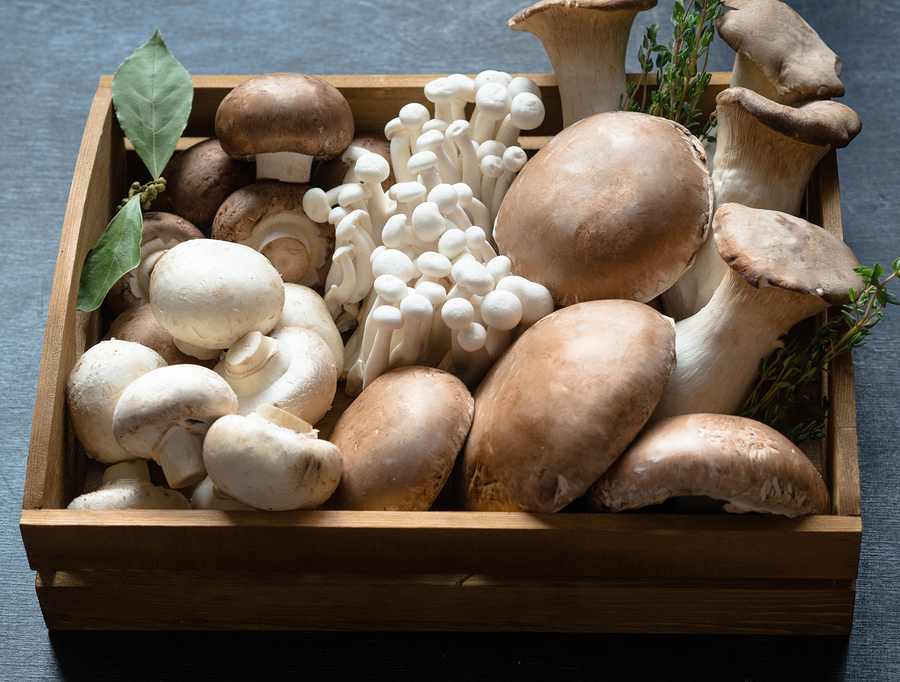Throughout history mushrooms have been regarded as magical and mysterious, a delicacy, and deadly. Foragers put their lives on the line when hunting fungi for medicinal and culinary use. Even today, foraging for wild mushrooms should be done with an expert mycologist by your side! Fortunately, at most local grocery stores you will find a tasty selection of mushrooms that are safe to eat.
Edible mushrooms offer many nutritional benefits including protein, vitamin D, potassium and other minerals, and antioxidants. Mushrooms contain compounds called polysaccharides that promote the healthy function of the immune system.
Many mushrooms have to be foraged by hand, while others can be harvested like a small crop. This results in a difference in price. You may want to occasionally splurge for these varieties of fabulous fungi:
Truffle, crown jewel of mushrooms, is one of the most expensive foods in the world. Trained dogs are required to sniff out truffles from beneath the roots of chestnut and hazel trees. Truffles are used in exotic dishes, side dishes, soups, and dips.
Maitake is a late summer and autumn fungi found at the foot of oak trees. Best harvested when young and tender to retain their flavor. These are wonderful for soups, sauces, and breads.
Chanterelle mushrooms are unmistakable with their cheery yellow-gold coloring. This mushroom has a woodsy, apricot flavor. Found only in the wild, chanterelles live in a symbiotic partnership with its host tree, allowing it to store nutrients it could not acquire on its own. Chanterelles pair nicely with eggs and over rice/other grains.
Crimini (“baby bella”) and porcini mushrooms have mild flavors and medium texture. Less expensive than the others, these can be used in a variety of recipes, from breads and muffins to sauces and stews.
Mushroom selection and storage can vary by type. Generally, mushrooms should be tender but firm to touch, not wet or gummy. Organic is best. Store in the fridge in a ventilated package to keep moisture out. Most mushrooms should be used within a week.
References
- Ware, Megan. “Mushrooms: Nutritional Value and Health Benefits.” Medical News Today. Posted 23 Feb 2017. Accessed 3 May 2017: http://www.mushroomharvest.com/extra_pages/slideshow.htm
- Whfoods.org. “Crimini Mushrooms” Accessed 3 May 2017: http://whfoods.org/genpage.php?tname=foodspice&dbid=97
- PBS.org. Avey, T., “The History Kitchen: Magical Mushrooms: The Allure of Edible Fungi” posted 1 April 2014. http://www.pbs.org/food/the-history-kitchen/edible-mushrooms/
- Friedman, Mendel. “Mushroom Polysaccharides: Chemistry and Antiobesity, Antidiabetes, Anticancer, and Antibiotic Properties in Cells, Rodents, and Humans.” Ed. Charles Brennan. Foods (2016) 5:4, 80. PMC. Web. 3 May 2017. https://www.ncbi.nlm.nih.gov/pmc/articles/PMC5302426/
- O’Neil C.E., Nicklas T.A., Fulgoni III V.L., “Mushroom consumption is associated with increased nutrient intakes and better diet quality in adult participants of the National Health and Nutrition Examination Survey (2001–2010).” FASEB J. (2013) 27, Ib350. https://www.omicsonline.org/mushroom-intake-is-associated-with-better-nutrient-intake-and-diet-quality-2155-9600.1000229.pdf
- MNN.com. “Wild Mushrooms: What to eat, what to avoid.” Oder, Tom. Posted 13 Oct 2013. http://www.mnn.com/your-home/organic-farming-gardening/stories/wild-mushrooms-what-to-eat-what-to-avoid
- Epicurious.com “A visual guide to mushrooms.” Sund, E. & Astley, C. Accessed 3 May 2017: http://www.epicurious.com/archive/seasonalcooking/farmtotable/visualguidemushrooms
- MushroomInfo.com Info on health benefits, research, nutrition. http://www.mushroominfo.com/benefits/

